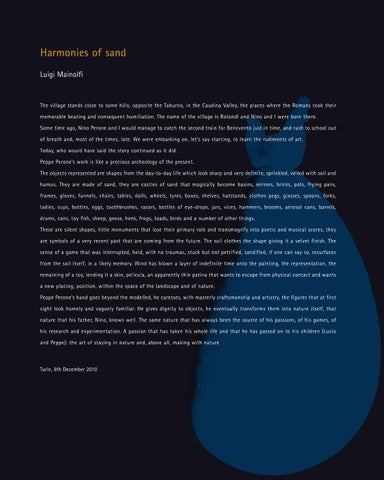Harmonies of sand Luigi Mainolfi
The village stands close to some hills, opposite the Taburno, in the Caudina Valley, the places where the Romans took their memorable beating and consequent humiliation. The name of the village is Rotondi and Nino and I were born there. Some time ago, Nino Perone and I would manage to catch the second train for Benevento just in time, and rush to school out of breath and, most of the times, late. We were embarking on, let’s say starting, to learn the rudiments of art. Today, who would have said the story continued as it did. Peppe Perone’s work is like a precious archeology of the present. The objects represented are shapes from the day-to-day life which look sharp and very definite, sprinkled, veiled with soil and humus. They are made of sand, they are castles of sand that magically become basins, mirrors, bricks, pots, frying pans, frames, gloves, funnels, chairs, tables, dolls, wheels, tyres, boxes, shelves, hatstands, clothes pegs, glasses, spoons, forks, ladles, cups, bottles, eggs, toothbrushes, razors, bottles of eye-drops, jars, vices, hammers, brooms, aerosol cans, barrels, drums, cans, toy fish, sheep, geese, hens, frogs, toads, birds and a number of other things. These are silent shapes, little monuments that lose their primary role and transmogrify into poetic and musical scores, they are symbols of a very recent past that are coming from the future. The soil clothes the shape giving it a velvet finish. The sense of a game that was interrupted, held, with no traumas, stuck but not petrified, sandified, if one can say so, resurfaces from the soil itself, in a likely memory. Wind has blown a layer of indefinite time onto the painting, the representation, the remaining of a toy, lending it a skin, pelicula, an apparently thin patina that wants to escape from physical contact and wants a new placing, position, within the space of the landscape and of nature. Peppe Perone’s hand goes beyond the modelled, he caresses, with masterly craftsmanship and artistry, the figures that at first sight look homely and vaguely familiar. He gives dignity to objects, he eventually transforms them into nature itself, that nature that his father, Nino, knows well. The same nature that has always been the source of his passions, of his games, of his research and experimentation. A passion that has taken his whole life and that he has passed on to his children (Lucio and Peppe): the art of staying in nature and, above all, making with nature
Turin, 8th December 2010
